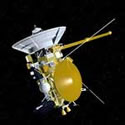
Image credit: NASA
NASA’s Cassini spacecraft continues to hurtle towards its distant rendezvous with the planet Saturn in July 1, 2004. Controllers had the spacecraft take some test photographs of a star, and the camera haze that showed up earlier in the mission appears to be clearing up, as they had hoped it would. The most recent communication with the spacecraft by the Goldstone tracking station last week indicated that Cassini is in excellent health and working normally.
NASA’s Cassini spacecraft continues to fly in good health, speeding toward a July 1, 2004, appointment to begin orbiting Saturn.
Test images of a star taken last week provide strong encouragement that a haze problem noticed on a Cassini camera lens is clearing up as anticipated, said Robert Mitchell, Cassini-Huygens program manager at NASA’s Jet Propulsion Laboratory, Pasadena, Calif.
A 60-day period of warming the spacecraft’s narrow-angle camera to a temperature just above freezing ended May 1. Heaters were built into the camera in anticipation of potential lens hazing; warming treatments have corrected similar hazing on other spacecraft.
Cassini’s narrow-angle camera performed flawlessly for the spacecraft’s December 2000 flyby of Jupiter. The haze first appeared last year, during the cruise between Jupiter and Saturn. Warming the camera to 4 degrees Celsius (39 degrees Fahrenheit) for eight days ending in January 2002 produced improvements, so the same heating was repeated for 60 days.
The new test images of the bright star Spica show that, by one measure, at least 90 percent of the image diffusion originally caused by the lens haze has been corrected. The improvement may actually be greater, because the new images were taken at a temperature warmer than the camera’s optimal operating temperature of about minus 90 C (minus 130 F). Another warming treatment, to last 26 days, began May 9.
About six months after Cassini begins orbiting Saturn, it will release its piggybacked Huygens probe for descent through the thick atmosphere of the moon Titan on Jan. 14, 2005. Cassini-Huygens is a cooperative mission of NASA, the European Space Agency and the Italian Space Agency. JPL, a division of the California Institute of Technology in Pasadena, manages the mission for NASA’s Office of Space Science, Washington, D.C. Additional information about Cassini-Huygens is available online at: http://saturn.jpl.nasa.gov .
Original Source: NASA/JPL News Release
